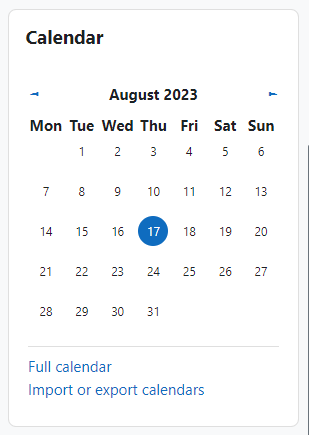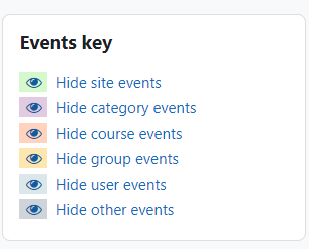Brad Reamsbottom
Adding Events using the Calendar Block

Moodle has a very robust calendar system which can be used to organize events for your students in Moodle. Course and user events may be scheduled, such as class events, quizzes, assignments, etc.
Logging into Moodle
There are a few ways to access your Moodle account. Either way you login to Moodle you will use the same username and password as the Bridge and UofL email accounts.
Temporary Moodle Access for users Without a UofL Account

Instructors may want to request Moodle access for users who are off-campus and do not have a UofL account.
In-depth Tutorials for Specific H5P Content Types
If you are using the H5P plugin in Moodle, this page will provide you with a list of links for in-depth tutorials for each specific content type.
Deleting Items from the Gradebook
You may have items in your Gradebook that you no longer need. There are a number of ways to remove them.
How to Create New H5P Content in Moodle

This tutorial will show you how to create new content in Moodle using the H5P plugin.
Changing Point Values for Exam Questions

Once you have your Moodle exam created you may want to change the default point value for each question. Moodle defaults each question to be worth one point.
Uploading a Zoom Cloud Recording to YuJa

If you have a video saved to the cloud in Zoom, you may want to add that video to YuJa in Moodle. This tutorial will walk you through the steps to manually add the video to your course using the external tool.
Using the Chat Rooms as a Student

One of the activities that instructors may use as a communication tool in moodle is the built in chat functionality. Chat rooms are generally set up as part of office hours, or in topic or weekly areas, in which case each chat will most likely correspond to the topic you are working within.
Emailing your Class in Moodle

Moodle currently does not have an internal email function associated with your course.
To send an email to your entire class, you will have to use your University of Lethbridge email account.
How to Preview a Moodle Quiz

Once you have your quiz set up in Moodle, it is highly recommended to preview your quiz to make sure everything looks and works as you wish before the exam opens to students.
My Course List is Gone!

If you had access to your Moodle classes during the semester but now they are gone, it could be one of two things.
Exporting your Student List from Moodle

If you wish, you can export your grades or your student list from Moodle into an Excel Spreadsheet.
Building Custom Content

Moodle allows you to create custom resources and content in many areas. Two such areas are labels and pages. This tutorial will walk you through how to build a custom page within Moodle, how to add and resize images, and how to add a YouTube video. At the end of this tutorial, you will know how to manipulate different types of content utilizing the WYSIWYG (What You See Is What You Get) editor.
Adding an Activity or Resource to your Course
Moodle allows you to add a variety of files and activities to course sections. To add an activity or resource to your course you must turn editing on. This tutorial will show you how to add a file such as a PowerPoint, .pdf or Word documents, and will instruct you on how to get started on creating activities.
Adding & Removing Sections (topics)

By default, Moodle displays 14 sections with a sequential numbering system (topic 1, topic 2, etc.) You may add more sections if required, or you may remove sections you will not be using.
Scheduling an Exam in the Testing Centre

To schedule an exam in the Testing Centre you will need have the following information:
- The requested dates for running your exam. Please note for larger class sizes you will have to run your exam for a minimum of 3 days. The scheduling works on a first come, first serve basis, so please get your exam dates to us as early as possible to get the dates you want.
- The number of students in your class.
- Your course name, number, and section
(more…)
Understanding Moodle’s Calendar Block

The Calendar block can be found on the right hand column of most courses, although instructors are free to move that if they wish.

If you go to the full Calendar (see link above), Moodle provides users with an integrated calendar that can hold 4 different types of events.
Global (event viewable in all courses – created by admin users)
Course (event viewable only to course members – created by teachers)
Group (event viewable only by members of a group – created by teachers)
User (personal event a student user can create – viewable only by the user)

Link and Add YuJa Quizzes in Moodle

This tutorial is for linking a pre-existing quiz into Moodle, NOT creating a whole new quiz within YuJa.
Zoom Learning Center

On-demand courses and live training sessions designed just for educators are now LIVE in the Zoom Learning Center (ZLC)! These materials cover everything educators need to know to set up their classrooms and establish routines for success.You can select from courses and sessions that cover:
- Getting Started with Zoom for Education
- Setting Up Your Classroom on Zoom
- Engaging Your Students on Zoom
- Zoom In: Breakout Rooms
And more!
Using Rubrics in the Moodle Forum Tool

Moodle now allows the use of rubrics in the Forum tool. In this tutorial, we will show you how to set up your rubrics and grade the forum with them.
Displaying Grades as Letter Grades

Moodle’s default is to display the Course Total as a numeric grade based on a percentage. You may wish to display this as a letter grade or both.
Using Crowdmark

Crowdmark is an online tool that allows students to submit pictures of handwritten/hand-drawn work. Below are links that contain articles and videos that can help you understand the process of setting up a Crowdmark Assessment.
Manually Entering Grades in Moodle’s Gradebook

You can manually enter grades into Moodle’s Gradebook using Grade Items.
Creating a Turnitin Assignment in Moodle

1. Make sure “Edit mode” is toggled on.
Click “Add an activity or resource.”

2. Narrow down the options by selecting the “Activities” tab.

3. Choose the “External tool” option from the list.

4. Provide a name for your assignment.

5. Choose the option “Turnitin” from the Preconfigured tool menu.

6. Click the “Maximum grade” field.

7. Once all your settings are input, click “Save and return to course” and wait for the submissions.

Scheduling Recurring Zoom Meetings

If you are using Zoom as part of your online class, you may want to schedule multiple Zoom sessions recurring at the same times.
Allowing Students to Copy/Paste into an Exam/Quiz
If you have an exam outside of the Testing Centre, and would like to allow students to copy/paste content into a Moodle quiz, you will have to adjust the security settings.
Deleting Scheduled Zoom Meetings

This tutorial will guide you through the steps on how to delete a Zoom meeting.
Editing Scheduled Zoom Meetings

You may need to edit a Zoom meeting that you have already scheduled. This tutorial will walk you through these steps.
Accommodated Exam Overrides

When delivering a Moodle Quiz as an open book exam, you as the instructor will be able to set up overrides for students.
How to Enter a Zoom Meeting
If you must attend a Zoom meeting but aren’t sure how to get started, this tutorial will walk you through the necessary steps to enter a Zoom meeting.
Setting your Course to Visible

By default, all Moodle courses are hidden to students until you as the instructor are ready to make the course visible.
How can I see which students are in my Moodle Group?

As a student in Moodle, you may have courses where your instructor has assigned you to work in groups. This tutorial will show you where you can see who is in your course group in Moodle.
Matching Grade Maximums with Crowdmark and Moodle
Making sure the grade maximum in Moodle is the same as the grade maximum in Crowdmark.
Moodle Exam Set Up Reminders
Important Moodle Exam Information
Please check over ALL Moodle exam questions BEFORE the opening date of the exam. Once students attempt the exam, errors in the questions are not easily fixed.
How do I View my Grades in Moodle?

Some instructors choose to post their grades in Moodle. If your instructor has told you to check your grades online this is how to access them.
Information About the Testing Centre
If you are new to taking exams in the Testing Centre, this article will walk you through the steps so that you know what to expect before your exam.
Closure Dates:
Turning on the Phonetics Module

If you are in a language studies course, you may be required to use the Phonetics Module on your Moodle exams. This tutorial will guide you on how to turn it on using your Moodle profile.
What file types can you submit via Turnitin?

You can set Turnitin to accept any file type in Settings > Optional Settings.
However, please be aware the different file types have limitations with Turnitin functionality.
For example, Excel files are able to be uploaded, but Turnitin only compares visible text. It does not look at formulas or hidden columns, and will likely not display properly in Feedback Studio when you go to mark it. Excel files must be made using Microsoft Excel and not a third party program that has the ability to save in the. XLSX format. Libre Office, Open Office, and more are not compatible with Turnitin and will not be accepted.
Creating an Assignment Drop Box in Moodle
Moodle has an Assignment Tool which allows for students to download/view the assignment in Moodle, as well as upload their assignment file into Moodle to be graded.
Student Advice for Submitting Work to Crowdmark

If you’re in a course that requires handwritten work (e.g. math or chemistry) your instructor may have chosen to have you use Crowdmark for assignments and tests.
To assist with remote assessment, the University of Lethbridge acquired a license for the Crowdmark online grading platform. If you’re in a course that requires handwritten work (e.g. math or chemistry) your instructor may have chosen to have you use Crowdmark for assignments and tests.
Administered or Assigned Assessments

There are two types of assessments available in Crowdmark. Administered and Assigned.
There are two types of assessments available in Crowdmark. Administered and Assigned. You will want to choose an Assigned assessment. The link below describes the difference between the two.
Syncing your Crowdmark and Moodle Rosters

This tutorial will walk you through the steps you need to take to sync the Crowdmark and Moodle Rosters.
Creating a Simple Gradebook in Moodle

There are many ways to set up your Moodle Gradebook. This tutorial will show you the most basic set up.
Switching from Instructor to Student View

As an instructor, you may want to switch your role to student view to see your course from a student perspective.
Embedding a YouTube Video in Moodle

You can include YouTube videos in your Moodle course. This tutorial will walk you through how to embed the video into your course.
Marking Glossary Submissions
Glossaries are a great way to get students to engage in material that usually takes the form of memorize and recall. As an instructor you can grade student entries in the glossary. This tutorial will walk you through that process.
Workshop Activity for Peer Assessment

Moodle’s Workshop Activity is a powerful peer assessment tool. This tutorial will walk you through the process of setting it up.
How to Adapt Existing H5P Content in Moodle
If you found H5P content online and wish to implement it into your Moodle course, you may follow these steps.
Testing Centre Fall Hours
Monday – Friday: 9 am – 9 pm Saturday: 9 am – 5 pm Sundays & Holidays: ClosedPopular Links
Main Menu
Choose a Category
